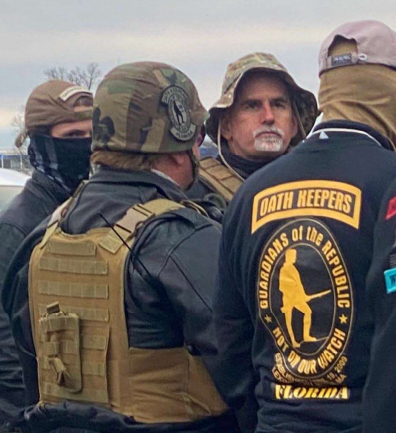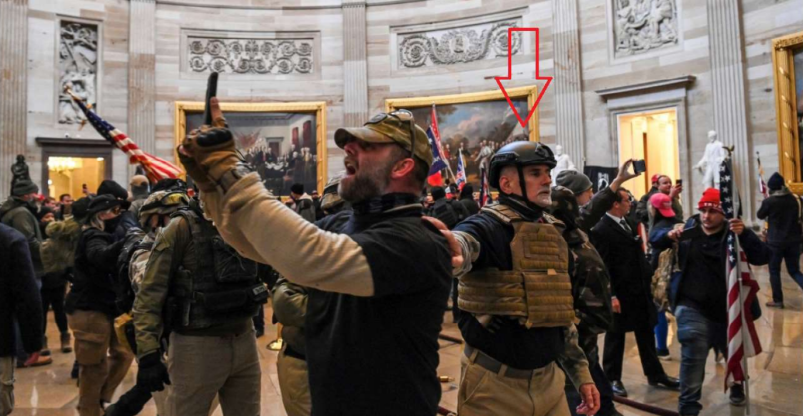The first plea deal has been reached in a massive conspiracy case alleging that several members of the Oath Keepers, the right-wing extremist group, planned together to interrupt Congress on Jan. 6.
The plea agreement hearing for Graydon Young, one of the alleged conspirators, was announced Wednesday morning and set for 2 p.m. before Federal Judge Amit Mehta.
In court Wednesday, Young said “I plead guilty, sir,” in response to Mehta’s prompts regarding two counts: Conspiracy, and obstruction of an official proceeding.
Earlier, he’d responded “Yes sir, that’s correct” when asked if he intended to enter into a plea agreement. He later said he was agreeing to cooperate with the government, including by testifying before a grand jury and at trial, and waived his right to have an attorney present during interviews with law enforcement.
Mehta estimated that sentencing guidelines for the crimes would amount to Young serving 63 to 78 months behind bars, or five to six and a half years — before factoring in the Justice Department’s potential future statement on Young’s cooperation, which is known as a 5K1.1 motion.
Young joins a growing list of Capitol attack defendants reaching plea deals with the government. The first such deal involved another Oath Keeper who was not part of the conspiracy case, the heavy metal guitarist Jon Schaffer.
Schaffer in April promised to cooperate fully with the government, and the Justice Department offered to sponsor him for the witness protection program, Mehta noted at the time. Schaffer’s attorney, Marc Victor, declined TPM’s request for comment Wednesday on the status of Schaffer’s cooperation.
Several others have since reached plea deals, but none with Young’s background. A federal prosecutor on the Oath Keepers conspiracy case, Kathryn Rakoczy, told Mehta on June 1 that prosecutors were hoping to make plea offers to members and associates of the group “over the next month or two.”
‘Looking To Get Involved In Helping…’
In various court filings, prosecutors didn’t portray Young as a leader in the alleged conspiracy, but they did note his presence at various key moments during the run-up to the attack, and on Jan. 6 itself. Crucially, they also said he was part of a “stack” formation of Oath Keepers that snaked its way up the Capitol steps and into the building itself.
Notably, an FBI agent said in a Jan. 18 affidavit in Young’s case, the defendant initially wore a wide-brimmed “boonie” hat while congregating with others outside of the Capitol. Then, prior to entering the building as part of the stack formation, the agent said, he changed into a tactical helmet.

In a February indictment, a federal grand jury alleged that Young and several others — the number of defendants in the case has since ballooned to 16 — conspired to interrupt the certification of Joe Biden’s Electoral College victory on Jan. 6. The indictment also charged Young with tampering with documents or proceedings, a product of him allegedly deleting his Facebook account two days after the attack.
On Dec. 3, according to the indictment, Young emailed the Florida Oath Keepers chapter a membership application and wrote, “looking to get involved in helping….”
Later that month, he allegedly advertised the Oath Keepers to a Facebook group as “a means to get more involved.” The recruitment effort seems to have worked: On Jan. 3, according to an indictment, another person who would later be charged with the conspiracy, Young’s sister Laura Steele, emailed both the Florida Oath Keepers chapter and future co-defendant Kelly Meggs, writing that Young had instructed her to contact them.
“My brother, Graydon Young told me to send the application to you so I can be verified for the Events this coming Tuesday and Wednesday,” she wrote to Meggs, according to the indictment.
Young flew to North Carolina on Jan. 4, a plan he’d allegedly set in place two weeks earlier, and the following day he departed for D.C. along with Steele and others.
In court Wednesday, Mehta ticked off Young’s actions that had affected sentencing guidelines: Young deleting his Facebook page, Mehta said, amounted to “obstructive conduct.” Mehta also characterized Young’s actions as a “substantial interference with the administration of justice” which involved “planning that was extensive in scope and preparation.”
‘Push, Push, Push’
According to the indictment, Young and others “prepared themselves for battle” with communication devices and reinforced vests, among other things, before creating the stack and forcibly entering the Capitol.
A superseding indictment — there’ve been four in the case — described Young’s alleged actions inside in more depth, including that he and others in the conspiracy “joined the mob in pushing against a line of riot police officers guarding the hallway connecting the Rotunda to the Senate, as [co-defendant Jessica] Watkins commanded those around her to ‘push, push, push,’ and to, ‘get in there, get in there,’ while noting, ‘they [the officers] can’t hold us.’” Young, Watkins and others retreated and then regrouped in the Capitol rotunda after the officers responded with chemical spray, the indictment said.
Later, Young and other Oath Keepers, allegedly gathered outside the building with Stewart Rhodes, the Oath Keepers founder who’s been labeled “Person One” in court documents.
The government has noted that Young isn’t among the top tier of alleged offenders in the attack: In a late March motion withdrawing their request for his pre-trial detention, prosecutors noted, “Defendant Young does not appear to have played a leadership role among his co-conspirators or to have himself been in advance contact with any other groups or individuals planning for violence in Washington, D.C., on January 6.”
“Moreover,” they said, “Defendant Young does not appear to have personally brought weapons to the Washington, D.C, area.”







Roger Stone, (I HOPE), hardest hit.
Nobody likes a snitch. He’s gonna be popular in prison.
So, a member of Oath Keepers is simultaneously a member of BLM and/or Antifa? It’s just so confusing…
Not counting the other half who were undercover fbi informants.